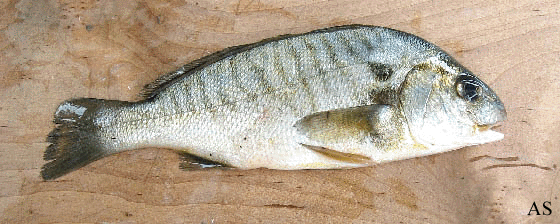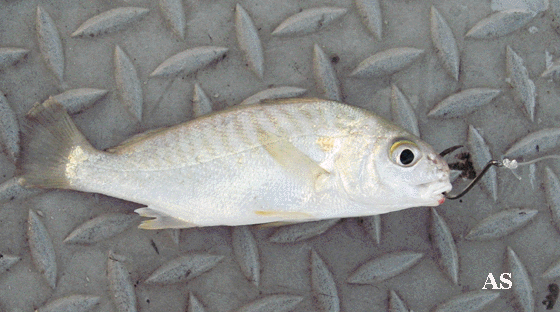
Spot Baitfish For Striped Bass Fishing

Live Spot are one of the best baits to use when fishing for striped bass from boats. Spot are very expensive, but stripers love spot. Many fishermen pay the price. They catch striped bass.
Hooking Live Spot
A good way to hook live spot is to put the hook through it's mouth and out up between it's nostrils, as shown on the photo to the right. Don't use too large a hook so as not to cause much damage to the Spot. Hooked this way the Spot will stay alive for a couple of hours, unless a striper finds it.
About Spot Baitfish
Spot are members of the family, Sciaenidae, and are known for the croaking or drumming sound they produce by resonating their large swim bladder. Spot occur along the Atlantic coast in estuarine and coastal waters from the Gulf of Maine to Florida; however they are most abundant from Chesapeake Bay south to South Carolina. They have been collected from the mainstream and all tributaries of Chesapeake Bay and have one of the most extensive distribution of any marine-estuarine fishes in the Bay. Spot are considered to be one of the major regulators of bottom invertebrate communities in the muddy, shallow zones of the Bay. They are also an important food source for other fish species including striped bass, bluefish, weakfish, shark and flounder.
Spot migrate seasonally, entering bays and estuaries in the spring, where they remain until late summer or fall when they move off shore. They mature between ages 2 and 3 at lengths of seven to eight inches with females producing at least 70,000 to 90,000 eggs. Their maximum life span is five years, although fish over three years are uncommon. Spawning occurs in offshore coastal waters in late fall to early spring. After spawning, adults may remain offshore, whereas larval spot will enter the Bay as early as December and appear in nursery areas in April and May. Primary nursery areas for juvenile spot occur in low salinity areas of the bays and tidal creeks, but they can also be found associated with eel grass communities. Young spot grow rapidly over the summer months, and by fall reach an average length of five inches. Adult and juvenile spot are most abundant in the Bay from April to October. As water temperatures decrease in the fall, most juveniles move to the ocean by December, but some may overwinter in deeper waters of the Bay.
The above information is from the Maryland Department of Natural Resources Fisheries Service.
Catching Spot Baitfish with a Cast Net
To see photos of catching spot baitfish by throwing a cast net follow this Link:
Cast Net
Larger Photo of Hooked Spot

